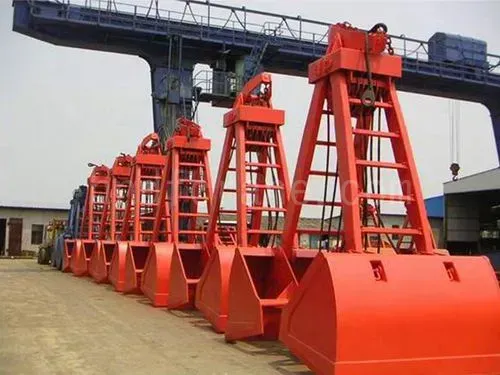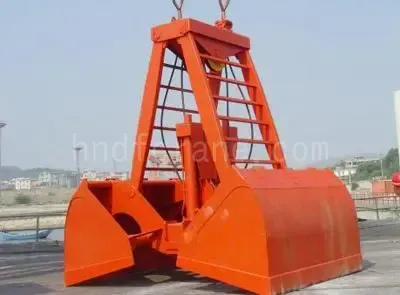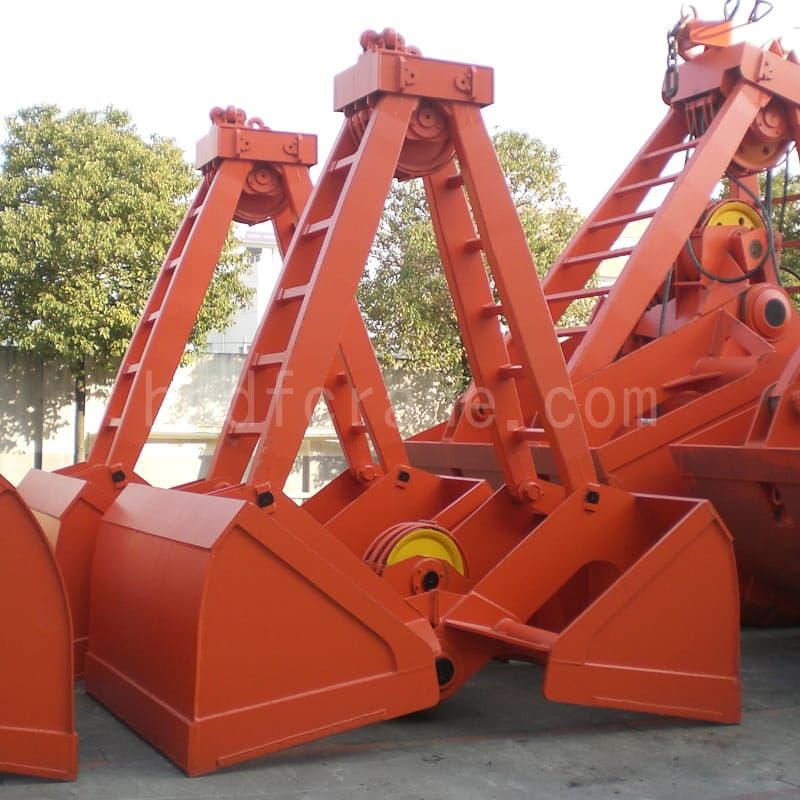Bidhaa Utangulizi wa mitambo ya kunyakua clamshell mbili za kamba
Ukamataji wa ganda la kamba mbili za mitambo zinafaa kwa kila aina ya korongo zilizo na muundo wa kifaa cha kuinua mara mbili, na hutumiwa zaidi katika bandari, bandari, barabara za ujenzi na madaraja na tasnia zingine.
Kulingana na sifa za nyenzo, inaweza kuwa na vifaa vya mwanga, vya kati, nzito na nzito sana. Inafaa kwa kunyakua kila aina ya mikusanyiko huru.
Kisha cranes mbalimbali. Ikiwa na seti mbili za reeli za injini (yaani, vipandikizi vya umeme), kila seti ya reli inaongoza kwa kamba ya waya, moja ambayo hutumika kama msaada kwenye fremu ya usawa wa kunyakua, na kamba nyingine ya waya hupitia mapigo ya sehemu ya juu na ya chini. mihimili ya kuunda kuzuia pulley, ambayo ina jukumu katika ufunguzi.
Ukamataji wa ganda mbili za kamba ni zana bora ya kupakia na kupakua shehena nyingi kama vile mchanga wa manjano, makaa ya mawe, unga wa madini, na mbolea nyingi katika mazingira magumu.
Mitambo miwili ya kunyakua clamshell ya kamba ina muundo rahisi, utaratibu wa kufungua na kufunga riwaya, rahisi kufanya kazi, na inaweza kukamilisha kwa usahihi hatua za kufungua na kufunga katika majimbo mbalimbali.
Ukamataji wa gamba la kamba mbili za kimakaniki hupitisha muundo wa dhamira-tatu, na programu ya ANSYS inatumika kwa uchanganuzi wa nguvu na uthibitishaji. Usambazaji wa uzito ni wa busara zaidi na maisha ya huduma ni ya muda mrefu.
Boriti ya kuzaa ya juu ya kunyakua kwa kamba ya kamba ya kamba ina vifaa vya lugs, ambavyo vinaweza kushikamana moja kwa moja na kamba ya kuinua ya crane.
Vigezo vya kiufundi ya mitambo ya kunyakua clamshell mbili za kamba

| Aina na Ukubwa | Kiasi(m3) | Uzito wa kufa (t) | Vipimo(mm) | Sheave Dia.(mm) | Tumia Urefu(m) | Kamba ya chuma Dia.(mm) | SWL(t) | ||||
| A | B | C | D | E | |||||||
| BS3[1.2]1.3A | 1.2(300) | 1.4(4) | 1900 | 2537 | 2488 | 2841 | 1200 | ø400 | 9 | ø17.5 | 3 |
| BS3[1.6]1.4A | 1.6(300) | 1.4(4) | 2100 | 2631 | 2559 | 3040 | 1300 | ø400 | 9.5 | ø17.5 | 3 |
| BS5[1.5]2A | 1.5(350) | 2(3) | 2000 | 2659 | 2667 | 3075 | 1260 | 445 | 8.5 | ø19.5 | 5 |
| 2(4) | 9.8 | ||||||||||
| BS5[2]2A | 2(350) | 2(4) | 2100 | 2778 | 2818 | 3248 | 1400 | 445 | 10 | ø19.5 | 5 |
| BS5[2.5]2A | 2.5(350) | 2(3) | 2100 | 2787 | 2715 | 3091 | 1600 | 445 | 8.5 | ø19.5 | 5 |
| BS5[3]2A | 3(400) | 2(3) | 2300 | 3130 | 2938 | 3362 | 1650 | 445 | 9 | ø19.5 | 5 |
| BS8[2.6]3.2A | 2.6(300) | 2.6(4) | 2300 | 3038 | 3257 | 3736 | 1800 | ø560 | 11 | ø26 | 8 |
| BS8[3]3.3A | 3(300) | 3.3(4) | 2380 | 3118 | 3287 | 3786 | 1900 | ø560 | 11.5 | ø26 | 8 |
| BS8[3.8]3.5A | 3.8(300) | 3.5(4) | 2550 | 3536 | 3286 | 3733 | 2000 | ø560 | 12 | ø26 | 8 |
| BS8[4.5]3.8A | 4.5(300) | 3.8(3) | 2500 | 3505 | 3503 | 3975 | 2300 | ø560 | 12 | ø26 | 8 |
| BS10[3]4A | 3(300) | 4(4) | 2380 | 3118 | 3287 | 3786 | 1900 | ø560 | 11.5 | ø28 | 10 |
| BS10[5]4A | 5(350) | 4(4) | 2615 | 3605 | 3503 | 3975 | 2400 | ø560 | 12 | ø28 | 10 |
| BS10[6]4A | 6(400) | 4(4) | 2800 | 3814 | 3758 | 4290 | 2150 | ø560 | 12.5 | ø28 | 10 |
| BS16[3.6]6A | 3.6(300) | 6(5) | 2500 | 3313 | 3810 | 4206 | 2100 | ø720 | 13.5 | ø32 | 16 |
| BS16[4]6A | 4(350) | 6(5) | 2500 | 3313 | 3810 | 4206 | 2200 | ø720 | 13.5 | ø32 | 16 |
| BS16[6]6A | 6(350) | 6(4) | 2900 | 3800 | 4249 | 4612 | 2400 | ø720 | 13.5 | ø32 | 16 |
| BS16[10]6A | 10(400) | 6 (3) | 3200 | 4000 | 3938 | 4673 | 2500 | ø650 | 12 | ø28 | 16 |
Jinsi ya kuchagua kunyakua sahihi
- Fafanua kusudi lako:
Kabla ya kuzama katika chaguzi, tafadhali fafanua mahitaji yako mahususi.Jiulize:
- Je, ungependa kushughulikia nyenzo gani? (Magogo, vyuma chakavu, mawe, n.k.)
- Je, unyakuzi utafanya kazi gani? (Kupakia, kupanga, kubomoa, n.k.)
- Je, kitaunganishwa kwa aina gani ya kifaa? (Gantry crane, crane ya juu)
- Je! ni uzito gani mahususi wa nyenzo unayonyakua?Idadi ya cubes za kunyakua?
Je, ni tani gani ya crane yako iliyo na vifaa vya kunyakua?
Kulingana na sifa za nyenzo zinazochukuliwa, kunyakua kawaida hugawanywa katika aina nne za msingi: nyepesi, za kati, nzito na nzito sana.
| Aina ya nyenzo za kunyakua | Kunyakua nyenzo | Uzito wa uwezo (t/m³) |
| Mwanga | Coke, slag, nafaka, viazi, chokaa cha anthracite cha ubora wa kati, saruji, udongo, changarawe, udongo, matofali yaliyovunjika, nk. | 0.5~1.2 |
| Kati | Peat, vipande vikubwa vya makaa ya mawe ya anthracite, makaa ya mawe yaliyounganishwa, udongo, chokaa, changarawe, chumvi, changarawe, matofali, bauxite, flakes ya oksidi ya chuma, saruji, mchanga na matofali katika maji, nk. | 1.2~2.0 |
| Nzito | Chokaa, udongo mzito, madini madogo na ya kati, miamba migumu, oksidi ya chuma yenye umbo la fimbo, madini ya chuma, unga wa makinikia wa risasi n.k. | 2.0~2.6 |
| Uzito kupita kiasi | Ore kubwa, ore kubwa ya manganese, unga wa madini ya risasi, nk. | 2.6~3.3 |
- Utangamano wa vifaa: Hakikisha kunyakua kunaendana na vifaa vilivyopo.
- Mazingatio ya Bajeti: Bei mbalimbali za kunyakua ni tofauti.Sawazisha bajeti yako kulingana na utendakazi na uimara wa kunyakua.
- Maoni na mapendekezo: Tafiti mtandaoni, soma hakiki za watumiaji, na utafute mapendekezo kutoka kwa washirika wa tasnia.
- Nenda kwa mtengenezaji wa crane kwa ukaguzi na majaribio kwenye tovuti kabla ya kununua: jaribu kunyakua chini ya hali halisi kadri uwezavyo.Tathmini utendakazi wake, urahisi wa utumiaji, na utendakazi kwa ujumla.
Kumbuka kwamba kuchagua kunyakua sahihi kunahitaji usawa kati ya utendakazi, usalama na gharama. Kwa kuzingatia mambo haya.





















































































